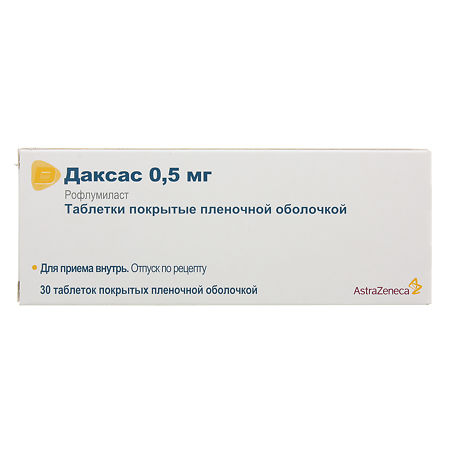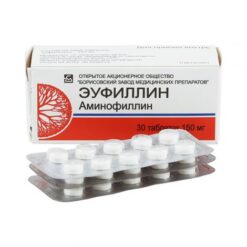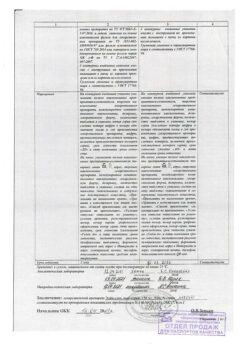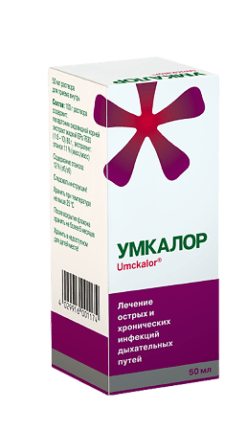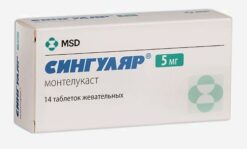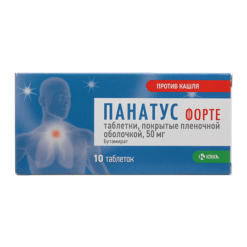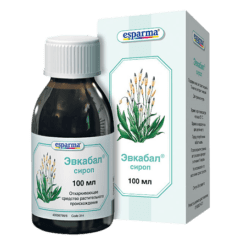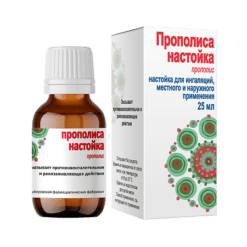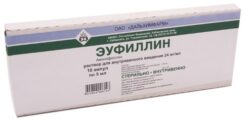No products in the cart.
Daxas, 0.5 mg 30 pcs.
€1.00
Out of stock
(E-mail when Stock is available)
Description
The action of roflumilast is aimed at eliminating the inflammatory processes associated with COPD. The mechanism of action is inhibition of FDE4, the main cyclic adenosine monophosphate – a metabolizing enzyme contained in cells involved in inflammatory processes, and is an important link in the pathogenesis of COPD.
The action of roflumilast mainly targets FDE4A, 4B and 4D, with similar potential in the nanomolar range. Affinity to FDE4C type is 5-10 times lower. This mechanism of action and selectivity also applies to N-oxide, which is the main active metabolite of roflumilast.
Inhibition of FDES4 leads to an increase of intracellular cAMP and a decrease of dysfunction of leukocytes, airway and pulmonary smooth muscle cells, endothelial cells and airway epithelial cells, and fibroblasts in experiment.
Stimulation of human neutrophils, monocytes, macrophages or lymphocytes (in vitro) showed that roflumilast and roflumilast N-oxide inhibited the release of inflammatory mediators such as leukotriene B4, reactive oxygen species, TNFα, interferon gamma and granzyme B.
In COPD patients, roflumilast lowers sputum neutrophil counts and also reduces the influx of neutrophils and eosinophils into the airways of healthy volunteers who received endotoxin.
Roflumilast is actively metabolized in the human body to form the main pharmacodynamically active metabolite N-oxide roflumilast. Since roflumilast and roflumilast N-oxide are involved in inhibition of FDE activity (in vivo), pharmacokinetics is described based on an assessment of the overall inhibitory effect on FDE4.
Indications
Indications
Supportive therapy in the treatment of severe COPD (post-bronchodilation forced expiratory volume in the first second (FEF1) should be less than 50% of the calculated proper value) in adult patients with a history of frequent exacerbations.
Active ingredient
Active ingredient
Composition
Composition
One coated tablet contains:
The active ingredient:
roflumilast 500 mcg.
Auxiliary substances:
Lactose monohydrate – 198.64 mg,
Corn starch – 53.56 mg,
povidone K90 – 3.9 mg,
magnesium stearate – 2.6 mg.
Shell composition:
Hypromellose 2910 – 3 mg,
Macrogol 4000 – 4 mg,
Titanium dioxide (E171) – 1.25 mg,
Iron oxide yellow dye (E172) – 250 µg.
How to take, the dosage
How to take, the dosage
The drug is administered orally in a dose of 500 mcg once daily.
The tablets should be washed down with water and taken daily at the same time, regardless of meals.
It may take several weeks to achieve a therapeutic effect.
There is evidence from clinical studies that Daxas can be taken for up to one year.
Particular clinical use of Daxas in patients with Child-Pugh class A liver dysfunction has not been clinically proven to recommend dose adjustments, so the drug should be used with caution in these patients.
Dose adjustment is not necessary in patients with renal disease.
Dose adjustment is not necessary in elderly patients (over 65 years of age).
Interaction
Interaction
The main step in the metabolism of rooflumilast is N-oxidation to form N-oxide rooflumilast with the participation of CYP3A4 and CYP1A2 isoenzymes. Both roflumilast and roflumilast N-oxide have intrinsic inhibitory activity against FDE4. Therefore, after roflumilast administration, the total inhibitory activity of FDE4 is the cumulative effect of both roflumilast and roflumilast N-oxide. Clinical studies of interaction with CYP3A4 isoenzyme inhibitors, erythromycin and ketoconazole, showed a 9% increase in total FDE4 inhibitory activity.
The interaction studies with CYP1A2 isoenzyme inhibitor, fluvoxamine, and CYP3A4 and CYP31A2 inhibitors, enoxacin and cimetidine, showed an increase of 59%, 25% and 47% in total FDE4 inhibitory activity, respectively. Combined use of Daxas with these active agents may lead to increased action and development of intolerance. In this case, treatment with Daxas should be reconsidered.
The administration of the cytochrome P450 system isoenzyme inducer rifampicin resulted in a decrease of total inhibitory activity of FDE4 by approximately 60%. Therefore, the use of potent inducers of this enzyme system (e.g., phenobarbital, carbamazepine, phenytoin) may lead to a decrease in the therapeutic effect of roflumilast.
Concomitant administration with theophylline resulted in an 8% increase in total FDE4 inhibitory activity. In an interaction study with oral contraceptives containing gestoden and ethinyl estradiol, total FDE4 inhibitory activity was increased by 17%.
There were no interactions with the inhaled drugs salbutamol, formoterol, budesonide and the orally administered drugs montelukast, digoxin, warfarin, sildenafil and midazolam.
Concomitant administration with antacids (a combination of aluminum hydroxide and magnesium hydroxide) did not change the absorption or pharmacokinetic properties of roflumilast or N-oxide roflumilast.
Special Instructions
Special Instructions
Daxas is a non-steroidal anti-inflammatory drug intended for maintenance treatment of patients with severe COPD with frequent exacerbations. Due to the fact that the general population of COPD is significantly dominated by patients over 40 years of age, spirometric confirmation of the diagnosis of COPD is required when prescribing the drug to patients under 40 years of age.
The indication for use of the drug requires that the post-bronchodilator BEP1 value be less than 50% of the calculated proper value.
Daxas is not intended to treat an acute attack of dyspnea (acute bronchospasm). The patient should be warned that to relieve an acute attack it is important to always have the medication prescribed by the physician to stop the attack Daxas is not effective in this situation.
In a year-long study, weight loss was observed more frequently in patients who received Daxas compared to patients who received a placebo. After discontinuation of Daxas, most patients recovered their body weight within 3 months.
In patients who are underweight, their body weight should be monitored at every visit to their physician. Patients should be advised to monitor their body weight regularly. If there is an unexplained or clinically significant decrease in body weight, Daxas should be discontinued and the trend monitored.
In the absence of adequate experience, Daxas should not be started in patients receiving continuous maintenance therapy with oral GCS, except for short-term courses of systemic GCS.
Daxas has limited experience with patients with latent infections such as tuberculosis, viral hepatitis, herpes virus and shingles.
The use of Daxas is associated with an increased risk of psychiatric disorders such as insomnia, anxiety, nervousness, and depression. Rare cases of suicidal ideation and behavior have been identified in clinical studies. Therefore, if patients report previous or current psychiatric symptoms or if concomitant therapy with other medications is planned that is associated with the potential for psychiatric disorders, a careful risk-benefit assessment should be made of the risks and benefits associated with initiating or continuing treatment with Daxas. Patients should be instructed to notify the prescribing physician of any changes in behavior, mood, or the appearance of suicidal ideation of any nature.
While adverse reactions such as diarrhea, nausea, abdominal pain, and headache occur mostly in the first weeks of treatment and mostly resolve with continued treatment, treatment with Daxas should be reconsidered if these symptoms persist.
Intolerance may occur in specific patient populations, particularly in black non-smoking women or patients treated with the CYP1A2 inhibitor fluvoxamine or with the two CYP3A4/1A2 inhibitors enoxacin and cimetidine.
There are no clinical data regarding concomitant treatment with theophylline as maintenance therapy. Therefore, concomitant treatment with theophylline is not recommended.
Impact on driving and operating ability
Because of the potential for adverse reactions, patients must exercise caution when driving vehicles and engaging in other potentially hazardous activities requiring increased concentration and quick psychomotor reactions.
Contraindications
Contraindications
Side effects
Side effects
These adverse reactions mostly occur during the first weeks of treatment and mostly disappear as treatment continues; most are mild to moderate.
Determining the frequency of adverse reactions:
Very common (â¥1/10).
Frequent (>1/100, <1/10).
Infrequent (>1/1000, <1/100).
Rare (>1/10,000, <1/1000).
Very rare (<1/10,000).
Digestive system disorders
Mental Health
Rare cases of suicidal thinking and behavior (including completed suicide) have been reported in clinical studies. Patients should be instructed to report all suicidal ideation to their physician.
Cardiovascular system disorders
CNS side
Endocrine system disorders
Metabolism and nutrition
Dermatological reactions
Allergic reactions
Muscular system disorders
Other
Overdose
Overdose
Symptoms that were more frequently observed in phase I clinical trials after a single oral dose of 2.5 mg and a single dose of 5 mg (10 times the recommended dose): headache, GI disturbances, tachycardia, dizziness, clouded consciousness, sweating, and arterial hypotension.
Treatment:In case of overdose, appropriate symptomatic therapy is recommended.
Roflumilast is largely bound to plasma proteins, so hemodialysis is not an effective method of excretion.
There is no data whether Roflumilast is amenable to peritoneal dialysis.
Pregnancy use
Pregnancy use
Daxas is not recommended for children under 18 years of age, pregnant women and during lactation.
The data on the use of roflumilast in pregnant women are limited.
The drug is not recommended for women of childbearing age who are not using reliable methods of contraception.
It cannot be excluded that the infant will receive the drug while breastfeeding, so if it is necessary to use the drug during lactation, the question of stopping breastfeeding should be decided.
In studies of human spermatogenesis, roflumilast at a dose of 500 mcg had no effect on sperm parameters or sex hormones when treated for 3 months and for the next 3 months after discontinuation of treatment.
In experimental animal studies, roflumilast has been shown to penetrate the placental barrier; it has reproductive toxicity. Pharmacokinetic data obtained in animals showed excretion of rooflumilast or its metabolites with breast milk.
Application in children.
Contraindicated: age under 18 years, efficacy and safety have not been established.
Additional information
| Shelf life | 3 years |
|---|---|
| Conditions of storage | At a temperature not exceeding 30 °C |
| Manufacturer | Takeda GmbH, Germany |
| Medication form | pills |
| Brand | Takeda GmbH |
Related products
Buy Daxas, 0.5 mg 30 pcs. with delivery to USA, UK, Europe and over 120 other countries.

